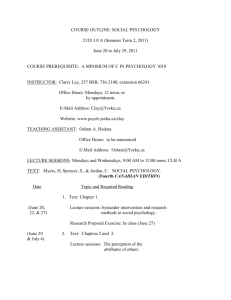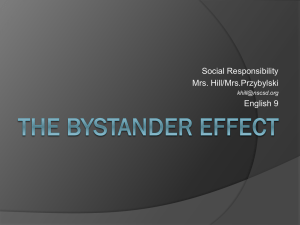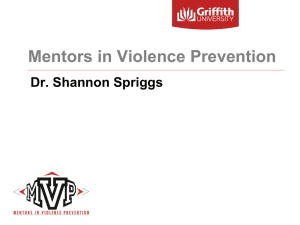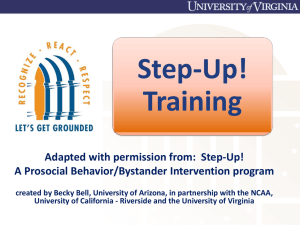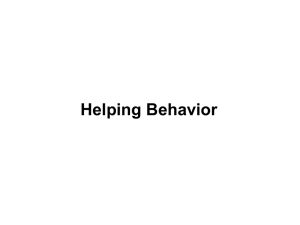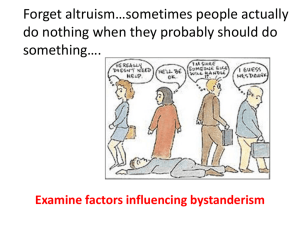Literatura
advertisement
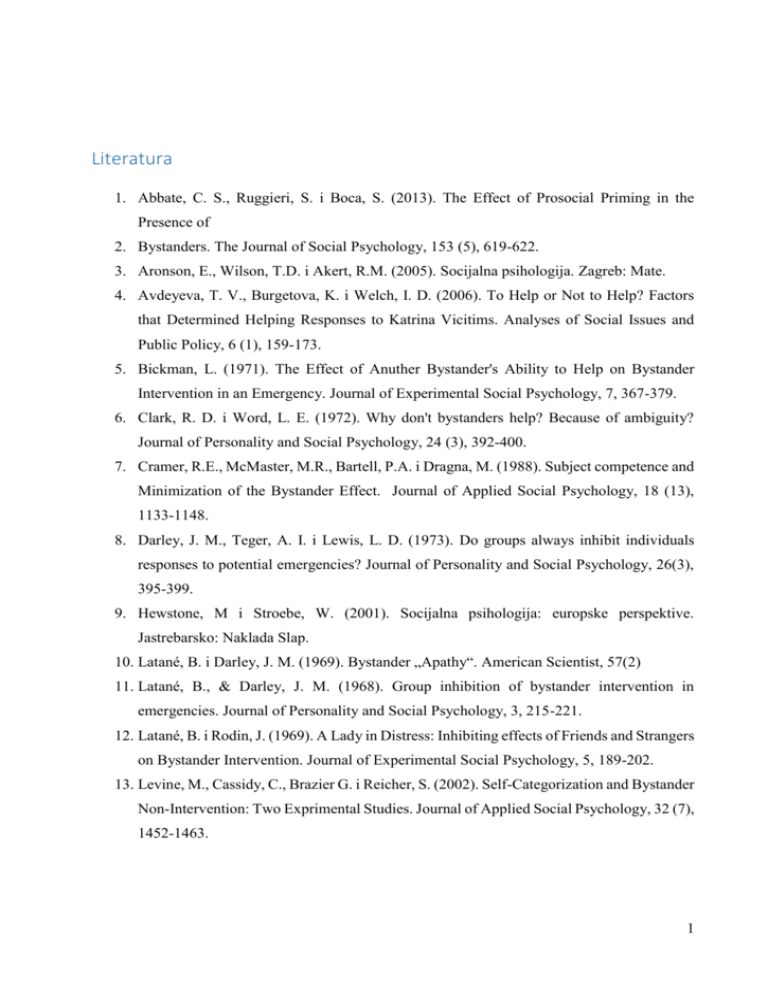
Literatura 1. Abbate, C. S., Ruggieri, S. i Boca, S. (2013). The Effect of Prosocial Priming in the Presence of 2. Bystanders. The Journal of Social Psychology, 153 (5), 619-622. 3. Aronson, E., Wilson, T.D. i Akert, R.M. (2005). Socijalna psihologija. Zagreb: Mate. 4. Avdeyeva, T. V., Burgetova, K. i Welch, I. D. (2006). To Help or Not to Help? Factors that Determined Helping Responses to Katrina Vicitims. Analyses of Social Issues and Public Policy, 6 (1), 159-173. 5. Bickman, L. (1971). The Effect of Anuther Bystander's Ability to Help on Bystander Intervention in an Emergency. Journal of Experimental Social Psychology, 7, 367-379. 6. Clark, R. D. i Word, L. E. (1972). Why don't bystanders help? Because of ambiguity? Journal of Personality and Social Psychology, 24 (3), 392-400. 7. Cramer, R.E., McMaster, M.R., Bartell, P.A. i Dragna, M. (1988). Subject competence and Minimization of the Bystander Effect. Journal of Applied Social Psychology, 18 (13), 1133-1148. 8. Darley, J. M., Teger, A. I. i Lewis, L. D. (1973). Do groups always inhibit individuals responses to potential emergencies? Journal of Personality and Social Psychology, 26(3), 395-399. 9. Hewstone, M i Stroebe, W. (2001). Socijalna psihologija: europske perspektive. Jastrebarsko: Naklada Slap. 10. Latané, B. i Darley, J. M. (1969). Bystander „Apathy“. American Scientist, 57(2) 11. Latané, B., & Darley, J. M. (1968). Group inhibition of bystander intervention in emergencies. Journal of Personality and Social Psychology, 3, 215-221. 12. Latané, B. i Rodin, J. (1969). A Lady in Distress: Inhibiting effects of Friends and Strangers on Bystander Intervention. Journal of Experimental Social Psychology, 5, 189-202. 13. Levine, M., Cassidy, C., Brazier G. i Reicher, S. (2002). Self-Categorization and Bystander Non-Intervention: Two Exprimental Studies. Journal of Applied Social Psychology, 32 (7), 1452-1463. 1 14. Levine, M., Prosser, A., Evans, D. i Reicher, S. (2005). Identity and Emergency Intervention: How Social Group Membership and Inclusiveness of Group Boundaries Shape Helping Behaviour. Personality and Social Psychology Bulletin, 31 (4), 443-453. 15. Eagly, A. H. i Crowley, M. (1986). Gender and Helping Behavior: A Meta-Analytic Review of the Social Psychological Literature. Psychological Bulletin, 100 (3), 283-308. 16. Fischer, P. i Greitemeyer, T. (2013). The Positive Bystander Effect: Passive Bystanders Increase 17. Helping in Situations With High Expected Negative Consequences for the Helper. The Journal of Social Psychology, 153 (1), 1-5. 18. Fischer, P., Greitemeyer, T., Pollozek, F. i Frey, D. (2006). The unresponsive bystander: Are bystanders more responsive in dangerous emergencies? European Journal of Social Psychology, 36, 267-278. 19. Garcia, S. M., Weaver, K., Darley, J. M. i Spence, B. T. (2009). Dual effects of implicit bystanders: Inhibiting vs. facilitating helping behaviour. Journal of Consumer Psychology, 19, 215-224. 20. Garcia, S. M., Weaver, K., Moskowitz, G. B. i Darley, J. M. (2002). Crowded Minds: The Implicit Bystander Effect. Journal of Personality and Social Psychology, 83 (4), 843-853. 21. Hortensius , R. i De Gelder B. (2014). The neural basis of the bystander efect – The influence of 22. group size on neural activity when witnessing an emegency. NeuroImage, 93, 53-58. 23. Karakashian, L. M., Walter, M. I., Christopher, A. N. i Lucas, T. (2006). Fear of Negative Evaluation Affects Helping Behavior: The Bystander Effect Revisited. North American Journal of Psychology, 8 (1), 13-32. 24. Markley, P.M. (2000). Bystander intervention in computer-medaited communication. Computers in Human Behaviour, 16, 183-188. 25. Piliavin, I. M., Rodin, J. i Piliavin, J. A. (1969). Good Samaritanism: An Underground Phenomenon? Journal of Personality and Social Psychology 13 (4), 289-299. 26. Rutkowski, G. K., Grunder, C. L. i Romer, D. (1983). Group Cohesiveness, Social Norms, and Bystander Intervention. Journal of Personality and Social Psychology, 44 (3), 545-552. 27. Shotland, R. L. i Heinold, W. D. (1985). Bystander response to Arterial Bleeding: Helping Skills, the Decision-Making Process, And Differentiating the Helping Response. Journal of Personality and Social Psychology, 49 (2), 347-356. 28. Thornberg, R. (2010). A Student in Distress: Moral Frames and Bystander Behavior in School. 2 29. Elementary School Journal, 110(4), 585-608. 3
